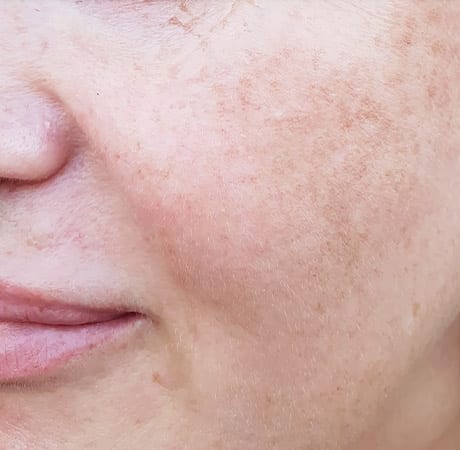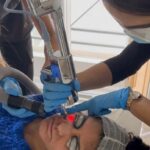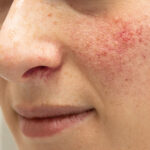
I have written at length in the past about what is known about the relationship between diet and acne but clearly science does not sit still and there is a recent paper in JAMA Dermatology I wanted to spend some time reading and sharing with you. I want to ensure that the information you gather from this page remains not only relevant but up to date.
The link between whether or not diet can cause acne is one that remains controversial, with mixed results and no clear answers despite decades of research. Clinical studies in nutrition are notoriously difficult due to a variety of factors: relying on self-reported food intake (human recall isn’t always the best for this), information is taken at a few set points even though diet can vary considerably over time, industry funding, the fact that we do not consume nutrients in isolation and our intake is in the form of whole foods or combination of foods eaten together, as well as a variety of potential confounding socio-economic factors to name a few.
Now bearing this in mind, let’s look at a recent paper published in JAMA Dermatology. This was an observational (cross-sectional), web-based cohort study to assess the association between dietary behaviour and current acne in adults carried out over approximately a one-year period (Nov 2018 – July 2019). The study had a large number of participants (n = 24,452) and the majority were female (75%). Nearly half of all participants (46%) reported past or current acne. Dietary intake was measured at baseline and every 6 months via 3 non-consecutive 24-hour dietary records; portion sizes were estimated from photographs, using standard containers, or direct measurements in grams or litres. Only those who provided at least 3 dietary records were included and mean intake of all dietary records for food groups in grams per day was calculated (fruit, vegetables, meat, fish, milk, dark chocolate, milk chocolate, refined cereals, snacks and fast foods, and fatty and sugary products). A number of potential confounders were adjusted for including age, sex, physical activity, smoking status, educational level, daily energy intake, number of dietary records completed, and depressive symptoms.
The study report found that there was a significant association between current acne and the consumption of fatty and sugary products (adjusted odds ratio [aOR], 1.54; 95% CI, 1.09-2.16), sugary beverages (aOR, 1.18; 95% CI, 1.01-1.38), and milk (aOR, 1.12; 95% CI, 1.00-1.25). An energy-dense dietary pattern (high consumption of fatty and sugary products) was associated with current acne.
Okay, so what do we make of this conclusion? Well, if one only reads the abstract, the key take-home message is that a “Western diet” high in sugar and fatty foods is associated with current or active acne in adulthood. If one already believes that diet has an impact in acne, this feeds well into one’s pre-existing bias and is a convenient study which can be cherry-picked to advocate dietary measures to control acne. However, it is not enough to read the abstract and a deeper dive into the methods leads to many relevant questions which haven’t been answered which may impact the results.
For example, firstly of the patients suffering with acne at any point in time, only 37% had a diagnosis made by a dermatologist; 44% had self-diagnosed the condition. This is in itself raises a few questions (was the diagnosis acne or something else, e.g. folliculitis, hidradenitis suppurativa). The majority of respondents were female but how many of these had a known clinical diagnosis of PCOS – a common cause of acne in adult women (affects 6-12% of women of reproductive ages); underlying PCOS could be a causative factor in acne and not the diet per se. How many of these women were taking hormonal contraceptives (and if so, which ones? – progesterone-only based pills can trigger acne). What do we know about lifestyle factors such as sleep or stress or skincare habits of those in the study and could these have affected the results? How many were using topical therapies or other treatments (e.g. peels, LED for acne)? Can we definitively say that it is the increased consumption of sugar or fat (which may lead to reduction in intake of other foods at a sitting) rather than a decrease in other nutrients that leads to this finding? If we implicate milk in this analysis, do we know whether it was full-fat or low-fat (previous data suggests low-fat is more of a problem). Lastly, looking at the numbers themselves, the strength of the association was relatively small demonstrated by the odds ratio (the greater this is over 1, the more likely a relationship is causal).
Analysing evidence is difficult and we need to be cautious in how we interpret clinical findings. The strengths of this study are no doubt the large sample size and an attempt to control for potential confounders, but there are a number of limitations which are hugely relevant. We do not have the data at the moment to say without doubt that dietary intervention will prevent or improve acne, and this type of lifestyle strategy is best thought of as an adjunct to tried, tested and validated acne treatments which already exist. I do not try and treat acne with diet alone, but I do think that a diet that is good for your skin is one that is good for your general health. This doesn’t mean becoming overly obsessive or fearful of eating sugar but more about being mindful of amount of consumption; it is about healthy eating patterns over a long, sustained period of time and not beating yourself up if you fancy cake with your cup of tea this afternoon.
I have tried to provide a balanced view of this paper. I note the association with sugar and acne presented but also recognise the need for more research in a skin condition which is multifactorial in nature and of varying severity. This does not mean that I think diet and lifestyle do not have a part to play in skin disease, but more that taking sensible measures in the way that we eat means that sugar can be a part of it and balance with nutrients and food is key. Let’s see what the science brings in coming years and remember, reading just the abstract is never enough!





